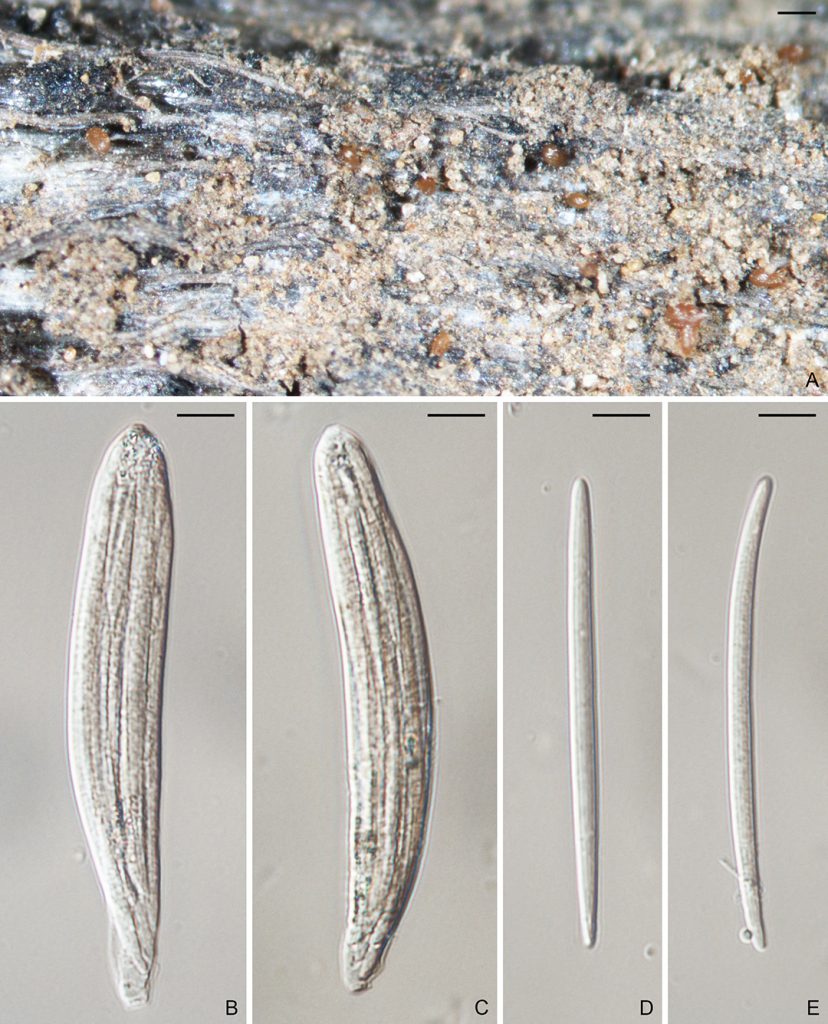
Figure. Gaeumannomyces tritici (BPI 626756). A. Ascomata. B–C. Asci. D–E. Ascospores. Scale bars: A = 200um; B–E = 10µm.
Gaeumannomyces tritici (J. Walker) Hern.-Restr. & Crous, in Hernández-Restrepo, Groenewald, Elliott, Canning, Mcmillan & Crous, Stud. Mycol. 83: 26 (2016).
MycoBank: MB816900.
≡ Gaeumannomyces graminis var. tritici J. Walker, Trans. Br. mycol. Soc. 58(3): 439 (1972).
Morphological description: Ascomata perithecial, superficial or submerged, solitary or gregarious, dark brown to black, 200–450µm in diam, with a cylindrical, hyaline to brownish neck, 150–300 × 55–80 µm. Paraphyses hyaline, septate, dissolving at mature. Asci unitunicate, clavate, 8-spored, 90–120 × 10–18 µm, with a refractive ring. Ascospores parallel in the ascus, hyaline to yellowish, long fusiform to filiform, straight or slightly curved, 0–5-septate, not constricted at the septum, smooth, 70–110 × 3–5 µm.
Conidiophores solitary, erect, straight or curved, unbranched or sparsely branched, hyaline, smooth. Conidiogenous cells phialidic, erect, terminal or intercalary, hyaline, smooth, 9–18 × 2–4 µm, with a cylindrical collarette, 1–3 × 1–2 µm. Conidia, lunate, allantoid to fusiform, straight to curved, hyaline, smooth, aseptate, 4–7 × 1–2 µm.
Specimens examined: Australia, New South Wales, on Triticum aestivum, 25 Feb. 1970, A.M. Smith, dar 19601 (BPI 626755); ibid., 12 Nov. 1969, L. Meakins, dar 19118 (BPI 626756). USA, New York, Geneva, on Triticum sativum, 5 Jul. 1921, R.J. Haskell and R.S. Kirby, BPI 626757.
Pathogenicity: Gaeumannomyces tritici can cause take-all diseases of wheat (Triticum), Barley (Hordeum), couch grass (Elymus repens), and wheatgrass (Agropyron) worldwide.
References:
Hernández-Restrepo M, Groenewald JZ, Elliott ML, Canning G, McMillan VE, Crous PW. 2016. Take-all or nothing. Studies in Mycology 83:19–48.
Geographical distribution: Australia, New South Walles. USA, New York.
Copyright 2022 by The American Phytopathological Society. Reproduced, by permission, from Luo, J., and Zhang, N. 2022. The Rice Blast Fungus and Allied Species: A Monograph of the Fungal Order Magnaporthales (https://my.apsnet.org/APSStore/Product-Detail.aspx?WebsiteKey=2661527A-8D44-496C-A730-8CFEB6239BE7&iProductCode=46826). American Phytopathological Society, St. Paul, MN.